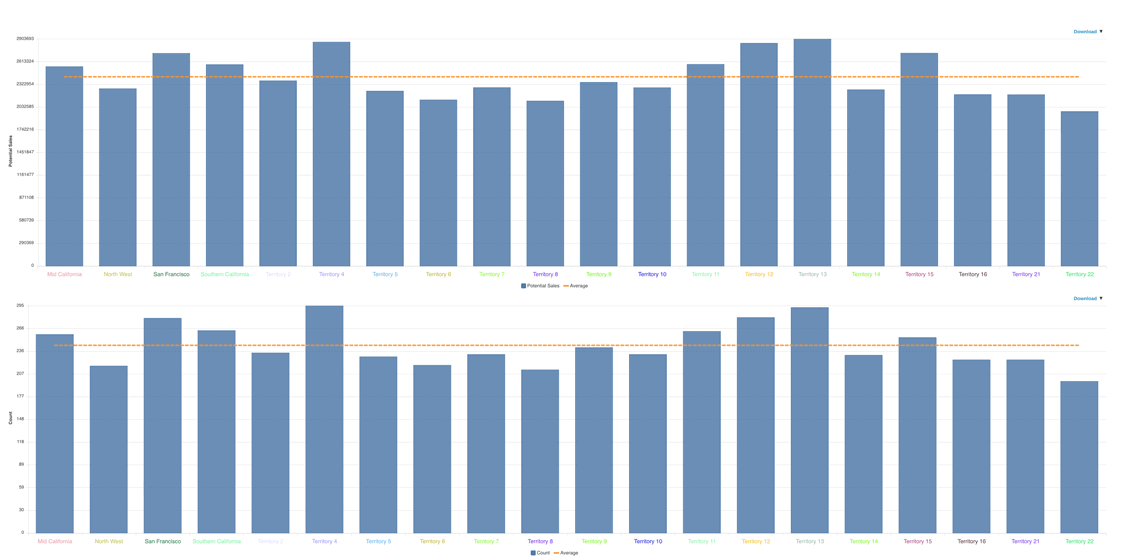Quick answer
Key takeaways:
- Visualizing sales data with maps makes coaching more effective; reps are 30% more likely to retain feedback when it’s shown spatially
- Route optimization insights can reduce travel time by up to 25%, creating more time for selling and stronger performance conversations
- Mapping reveals territory imbalances and overlooked opportunities, helping managers coach more fairly and strategically
- Coaching through questions and reflection, supported by clear visuals, builds more self-sufficient, engaged salespeople
Sales team coaching is one of the most powerful ways to grow your reps' skills, boost their confidence, and improve overall sales performance. With the help of mapping software, you can take your coaching to the next level by driving engagement, visibility, and smarter planning.
This guide shows you how to combine visual tools with coaching techniques that empower your team and promote self-driven improvement.
Visualize Sales Data for Better Coaching
Mapping software turns raw numbers into clear, visual intelligence. By plotting performance data on a map, you gain instant context around customer activity, deal values, and rep performance across regions. This enables a more nuanced approach to coaching a sales team, guided by location-based insight rather than guesswork.

When you can visually assess coverage, opportunity gaps, and underperforming areas, you can tailor your strategy to each rep’s territory, which supports:
- Fairer, more effective coaching
- Goals aligned with geographic realities.
Whether you're analyzing win rates or pipeline velocity, spatial context reveals coaching opportunities that spreadsheets alone can't.
Plan Targeted Campaigns and Prospecting
Map software enables smarter segmentation for outbound campaigns and prospecting. By visualizing ideal customer profiles or historical win data, you can guide reps to focus on the right neighborhoods, industries, or business types. This approach improves campaign efficiency and ensures your team targets high-value leads.

Use heat maps and demographic overlays to identify where prospects with similar traits are clustered. From there, you can coach your sales team to tailor messaging and prioritize outreach based on location-specific needs. This makes coaching a sales team far more strategic, helping reps spend less time guessing and more time selling. It also aligns closely with effective sales onboarding strategies by giving new reps context and direction early in their ramp-up.
Optimize Sales Routes
for Maximum Efficiency
Sales route optimization is crucial for reps managing large territories. Mapping software automates route planning based on meeting priorities, traffic patterns, and proximity to other accounts. This helps your team cover more ground in less time and reduces burnout, which is essential for time-strapped field teams looking for better sales time management tools.

Use routing insights to coach sales teams on how to structure their days for productivity. Efficient routes lead to more face time with prospects and customers, equating to closing deals. Incorporating these tools into your regular coaching process makes territory travel a strength rather than a struggle.
Identify and Correct Territory Inefficiencies
Unbalanced sales territories can lead to:
- Missed revenue
- Uneven workloads
- Frustrated reps.
By mapping CRM data geographically, you can uncover territory overlaps, underserved regions, or reps with too many accounts. This insight supports better decisions around realignment.

Territories balanced on potential sales
Territories balanced on customer count
As part of coaching a sales team, territory optimization ensures fair distribution of opportunity and workload. By visualizing these imbalances, managers can redistribute accounts or rezone territories to better reflect market potential. If you're managing coverage across large teams or regions, sales territory management features help you spot inefficiencies and make adjustments faster and more accurately.
Layer Datasets for Strategic Coaching
By overlaying different types of information, you can uncover patterns that aren’t visible in spreadsheets or dashboards alone. This layered approach offers a holistic view that drives smarter, more strategic coaching decisions.
Here are some examples of valuable data combinations:
- Customer data + demographics: Identify where high-potential prospects share similar traits or locations.
- Customer data + competitive insights: Spot regions where your reps are up against tough competition.
- Quota attainment + territory potential: Tailor coaching based on opportunity, not just performance.
- Internal sales data + third-party overlays: Reveal hidden market trends and gaps in coverage.
This approach makes coaching a sales team more personalized and data-driven. When you coach sales teams with contextual insight, reps feel supported rather than scrutinized, and results improve.
These insights become especially powerful when paired with mapping software for business, which offers tools that scale across industries and team sizes. The ability to combine sales, territory, and customer data is one of the standout CRM mapping software features that enhances coaching impact.
Implement an Ongoing Coaching Process
Sales coaching isn’t a one-time event; it’s a continuous practice. Use mapping insights to fuel weekly check-ins, quarterly reviews, and ongoing training sessions. This helps reinforce learning, track progress, and adapt strategies in real time.
By embedding visual tools into your coaching process, you provide a consistent framework for growth. Managers can revisit map-based insights regularly to track territory changes, lead quality, and performance trends, keeping coaching sales team efforts focused and forward-looking.
- Use visual tools to reduce ambiguity: Maps provide clarity on where reps should focus their time.
- Encourage data ownership: Help reps engage with their own performance data in spatial context.
- Align coaching with CRM visualization: Leverage mapped CRM data to drive coaching agendas.
Final Tips for Coaching Sales Teams
Ultimately, coaching a sales team is most impactful when rooted in data, tailored to geography, and built on a culture of ongoing development. Whether you're just learning how to coach a sales team or refining a mature strategy, location-based insight turns good coaching into great results. If you're exploring tools to get started or scale, see eSpatial pricing plans for options that fit your team.


